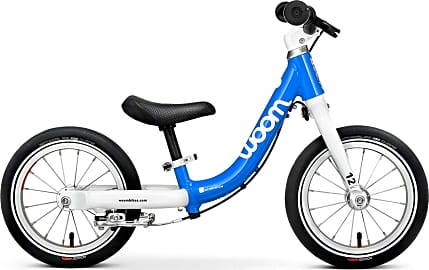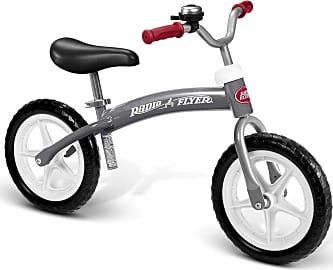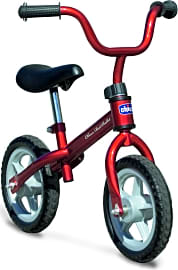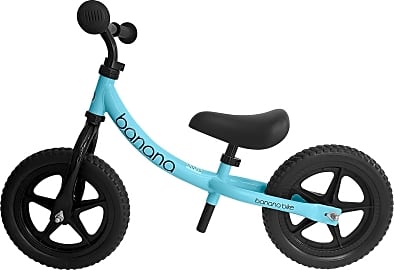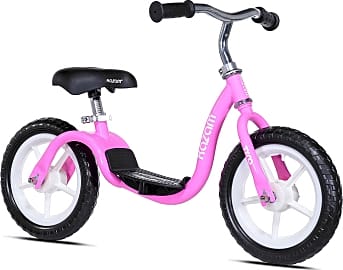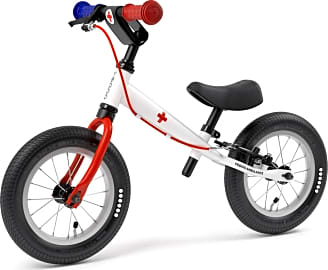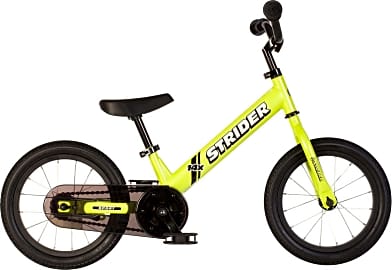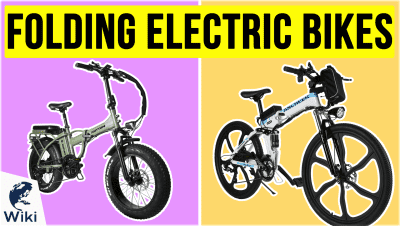The 10 Best Balance Bikes

This wiki has been updated 38 times since it was first published in April of 2015. If your child isn't quite ready for a big kid's bicycle, but he or she is hankering for a little independence, then it's time to invest in one of these balance bikes. Under proper adult supervision, they're a good precursor to training wheels on a pedal bike, and will help develop a little one's sense of balance and coordination while providing an appropriate amount of mobility and freedom. When users buy our independently chosen editorial recommendations, we may earn commissions to help fund the Wiki.
Editor's Notes
June 26, 2019:
Kids are unpredictable, so my thinking with this topic was to maintain options that won't only grow with a child, but can also help parents expect the unexpected. Additionally, kids tend to grow up very fast, so these balance bikes need to be able to grow up along with them so that they aren't rendered obsolete in just a couple years. A majority of our options feature things like adjustable seats, easy-to-grip handlebars, low profiles for easy mounting, and durable frames for withstanding impacts. Safety is also a major consideration for these bikes, so never leave a young child unattended!
The Strider 12 Sport is just an all-around dependable choice for a kid's first bike, thanks to the height adjustable seat, puncture-proof tires, and durable steel frame. I decided to add the Woom 1 for its wide wheelbase, easy-access rear hand brake, and integrated steering limiter to prevent swerving, which definitely comes in handy for young children who are just learning to find their balance. Maintained the Radio Flyer Glide & Go for its classic design and high-traction tires. The addition of a ringing bell is also pretty cool, albeit unnecessary. Included the Banana Bike LT for its convenient step-through design and twin-bearing headset. It's also pretty easy to lift for transport. Maintained the Kazam Tyro for its patented step-in footrest. The adjustable hand lever and aluminum rear V-brakes on the YeDoo TooToo allow for dependable control when it comes to slowing down and stopping, while the reflective tire dots ensure plenty of visibility should your little tyke be riding under your supervision at night. Also maintained the YBike Toddler for its dual rear wheels, which provide extra stability on a variety of terrains. Finally, I added the Strider 14X because of its convertible design that can truly grow with your child, thanks to the inclusion of a pedal installation kit for when Junior is ready to take his riding skills to the next level.
Walk Before You Ride
First, the speed will necessitate that the kid picks his or her feet up off of the ground, as the bike will be moving too quickly for their legs to keep up.
If you ride a bicycle, there's a good chance that you learned the way thousands, if not millions of children have learned over the past few decades, and that's by training wheels. You may recall that training wheels are smaller wheels that attach to the back portion of a bike frame so that they flank and provide balance to the bike's back wheel.
Training wheels are great in that they give your kids an opportunity to get a feel for pedaling a bike before they have to also learn how to balance it. The big problem with that method, however, is that the balancing act is often the hardest part, and as soon as a lot of kids feel that the security of the training wheels has been taken away, they panic. Falling off of a bike hurts, so their fear is justified.
What a balance bike does is enter the scene before the larger bike with training wheels is even a thought. These balance bikes are essentially small, two-wheeled bikes without any pedals or gears. They're built low enough to the ground that a child can use his or her feet to move it along, while still getting a feel for the biking experience.
At first, this may seem silly. How could the experience of walking a bike along actually help teach you how to balance it? Well, balance and speed share a fascinating relationship. It turns out that the faster you ride, the easier it is to balance on a bicycle, or even a motorcycle. That's why it's important to run along side your child on his or her first attempt to ride a pedaled bike without training wheels, so they can build up speed before you let go.
When (and I mean when) your little one eventually builds up enough speed on his or her balance bike–going down a hill, for example–, two things will happen. First, the speed will necessitate that the kid picks his or her feet up off of the ground, as the bike will be moving too quickly for their legs to keep up. Second, once those feet come off the ground, the bike, moving quickly enough to do so, will balance itself.
It's experiences like this that make it much easier for kids to transition to a bike with training wheels, and then a bike without them. By that time, they'll be so comfortable on a bike, and so experienced with the ease in balancing one, that they'll ride off into the sunset without you.
Minor Variations
I've always found the simplicity of a bicycle very appealing. Even with a dozen gears added to the frame, there's an elegance to the streamlined nature of bikes, to the way in which they're all essentially the same machine. Sure, some of them are easier to ride up hills or get up to higher speeds, but the mechanics of a bike never really change.
As you evaluate the balance bikes on our list, you'll notice that the similarities among them far outnumber their differences.
As you evaluate the balance bikes on our list, you'll notice that the similarities among them far outnumber their differences. Still, there are some perhaps unexpected particulars for you to consider when making your selection.
For starters–and this might be the most important variable in your choice–, you'll want to take a look at the style of the bike. This includes color, and if you follow the price links to a given bike, you'll see that several of them come in multiple colors. It also includes the nuances of its shape. While some of these bikes have their seats placed in more of a low-rider position, others feel more like mountain bikes or road bikes.
Next, you're going to want to look at the tire material. Some of these bikes boast actual rubber tires complete with inflatable tubes. This type tends to be more durable and is significantly easier to maintain than its plastic counterpart, but it also demands more upkeep, like making sure the tires are inflated and fixing flats.
Finally, check the weight of each bike. When your little one gets tired, it's up to you to carry the thing around, and a few pounds in this department can make all the difference, especially if you've got the bike in one arm and your kid in the other.
A Dandy Of A Time
One of the reasons that it took a while for the bicycle to catch on as a popular means of transportation, or as an instrument of leisure, is that, until its invention, human beings hadn't been asked to balance anything of its kind. The only comparable experience to riding a bike at that point in history was riding a horse, and horses either balanced themselves or they were taken out behind the shed, never to return.
In 1818, Baron Karl Drais invented something called the dandy horse, which was, for all intents and purposes, a balance bike for adults. It was a full-sized bicycle without pedals or gears. It had a hinged front wheel to allow for additional steering, but it didn't have any brakes.
Use of the dandy horse is one of the things that prepared the populace for the explosion of the bicycle in the middle of the 19th century, but its design faded well into the background until the balance bikes we now use for our kids came back into style over the past few decades.


